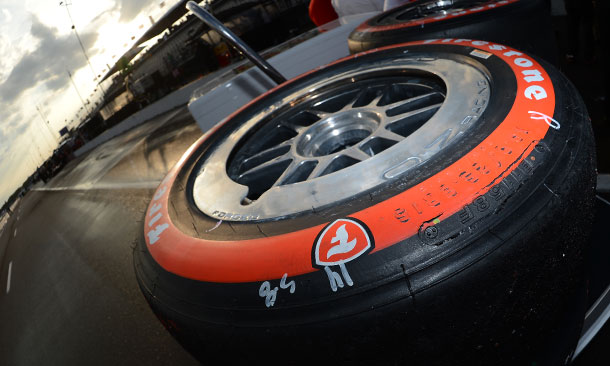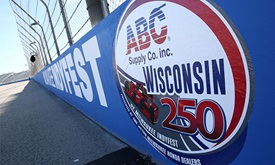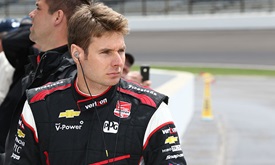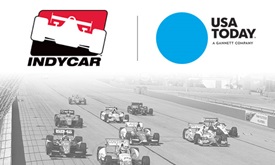The engineers' spin: Passion for science
FEB 28, 2015
Editor's note: Cara Adams, senior project engineers for Firestone, shares some of her background and experiences in engineering in "The Engineers' Spin" -- a monthly behind-the-scenes look at Firestone Racing's Verizon IndyCar Series program from the perspective of the people that make the tires roll.
In Akron, Ohio, our staff of chemists, engineers, and technicians design the tires you see in the Verizon IndyCar Series. I am the lead engineer responsible for the design of superspeedway tires, including the tires you see at the Indianapolis 500. We work very hard to make sure we bring the best possible tire to all of the events on the Verizon IndyCar Series schedule. I get to travel to tire tests, team tests and aero kit tests, and we’re always present at every race to monitor the performance of our tires, and answer questions from teams, drivers and team engineers.
That’s a pretty cool job, you say? Why, yes. Yes, it is.
Being that it is National Engineering Month, I’d like to share my story on how I came to have this awesome job in the hopes of inspiring a young student to pursue engineering or maybe even to provide some guidance to someone currently studying in this field.
I was interested in science from an early age, and I had two big influences in my life that helped cultivate that love of science – my mom, a science teacher, who held neighborhood science camps, and my grandfather, who worked as part of the launch team for the Space Shuttle missions at NASA.
That love for science carried over into my education, as I took as many science classes as possible and entered science fairs throughout high school. Once I graduated, I decided to attend the University of Akron and declared to major in mechanical engineering.
Now I’ve gone into detail on my love for science, but my passion for all things automotive didn’t start until my sophomore year of college, when I wandered into the Formula SAE (Society of Automotive Engineers) Machine Shop late one fall. Formula SAE is a collegiate competition where students design, build and race their own open-wheeled cars. Between SAE and riding in a friend’s supercharged ’92 Mustang, I was instantly hooked on all things racing.
In addition to my engineering classes, learning about cars in my spare time and racing Formula SAE, I decided to start tearing apart my car, a ’95 Mustang, to make it faster. I started with things like exhaust, before moving on to the transmission, interior, brakes and suspension. One afternoon, I decided to take my engine out to properly detail the engine bay. Since it was out, I decided I should take advantage of the opportunity, so I rebuilt the engine in the hopes of, of course, making it faster. It actually ran faster when I put it all back together.
Upon graduation, I interviewed at a couple of different automotive companies, always keeping an eye out for a company with a racing heritage. When a position at Firestone came open, I felt it was a perfect fit for me – a strong automotive company with unmatched roots in racing and a storied tradition of performance and innovation. It was a company that I felt I could be proud to work for.
I started in vehicle dynamics before, as I like to say, pestering my way onto the race team. I started out working on road course tires, and now have the privilege of being part of the team that designs tires for the Verizon IndyCar Series.
Now that you have a little background on me and my love of all things science and racing, let’s look at what makes the engineering field so special.
Science, technology, engineering and mathematics play a very important role in what Firestone Racing and the Verizon IndyCar Series do on the track each race weekend. For example, take the fueling of the race car. The engineers have to tell the fuelers how long to add fuel to get to the proper volume in the tank. To know how much fuel goes in, engineers must know the fuel efficiency of the engine based on the driver and the lap speeds at that particular track. They then predict how many laps the car will need to go before they stop next. Adding more fuel than necessary costs teams time in the pits and adds weight to the car; while not adding enough fuel could mean the driver runs out on the track or has to pit off sequence.
At Firestone, we use math and science every day. Our chemists and chemical engineers develop compound formulations using chemistry, math and other sciences that are specifically designed to meet the grueling on-track demands of IndyCar tires.
Our engineers use physics, math and other sciences to design the structure of a race tire to make sure it holds the loads placed upon the tires, which can be upwards of 3,000 pounds on a single tire at certain tracks. The tire must also be able to transmit the forces of the engine and transmission to make the car accelerate, they must deliver all the braking forces and they hold the car to the racetrack at the Indianapolis Motor Speedway as it corners over 200 mph.
I consider myself very lucky to be able to use my passion for math, science, engineering and quality at work. I am privileged to work designing tires for the Verizon IndyCar Series, and I am always excited to share that passion. And I am privileged to share my love of science and engineering with the younger generation, by mentoring students and helping to guide the next generation of scientists and engineers.
Get more information about the science and engineering that goes into producing the Firestone Firehawk tires for the demanding Verizon IndyCar Series schedule, visit www.FirestoneRacing.com.


















